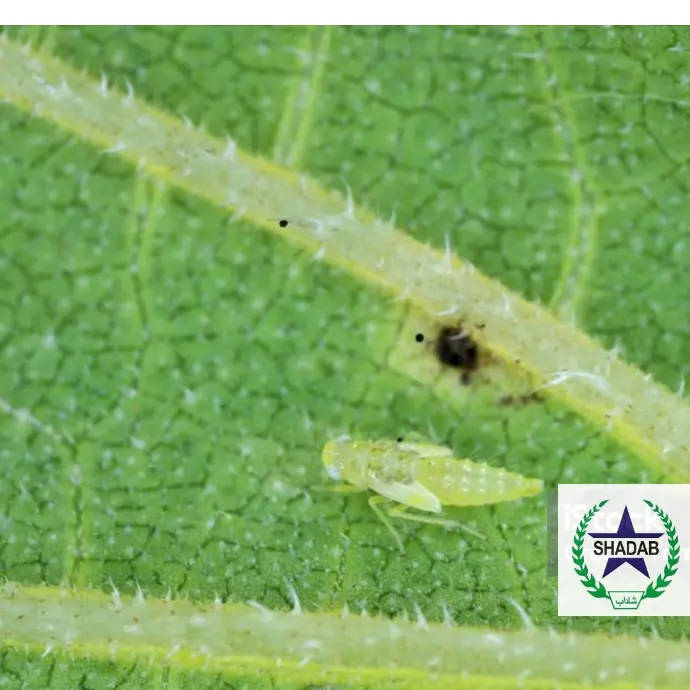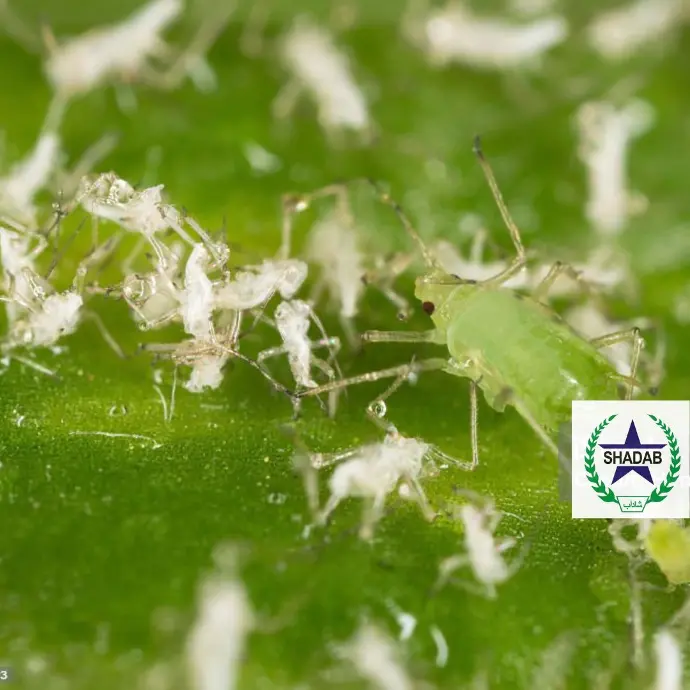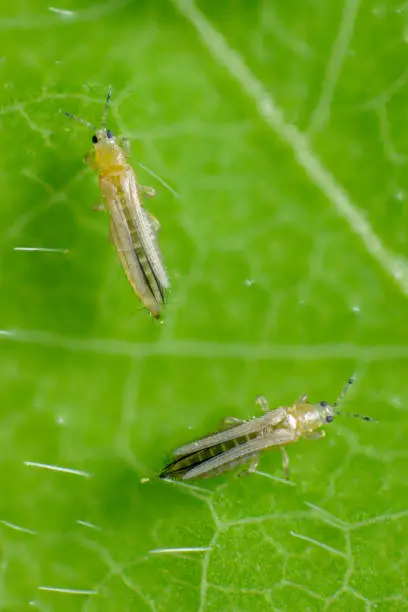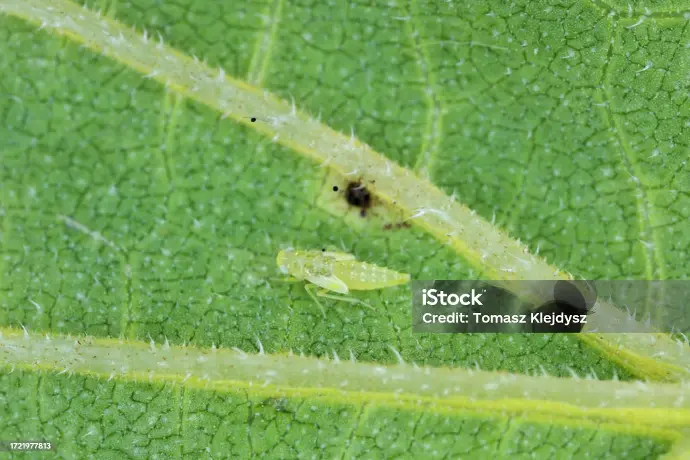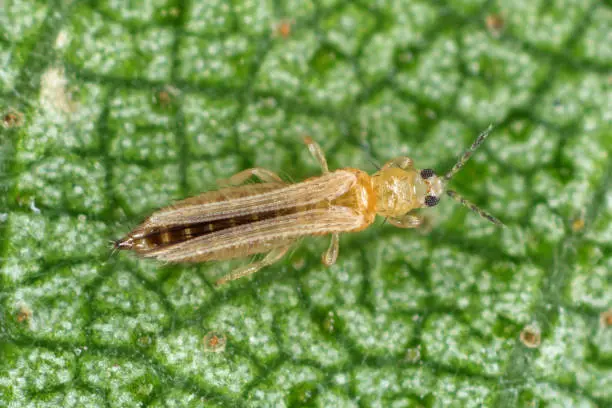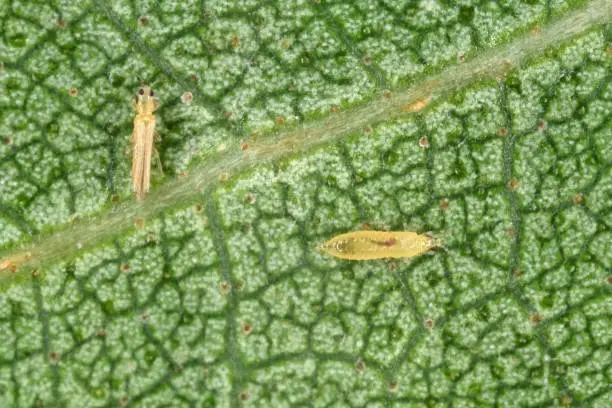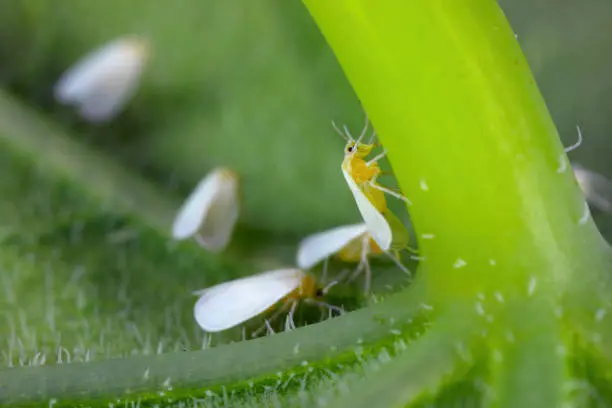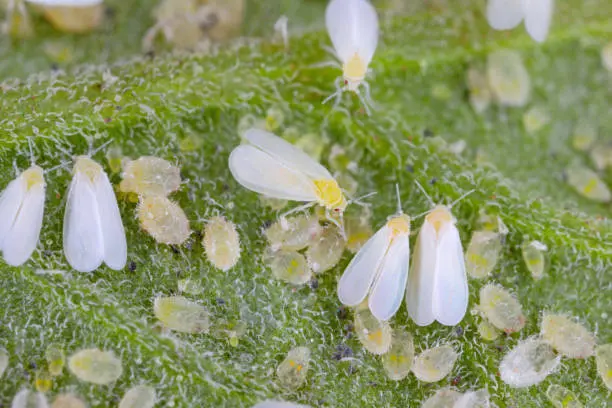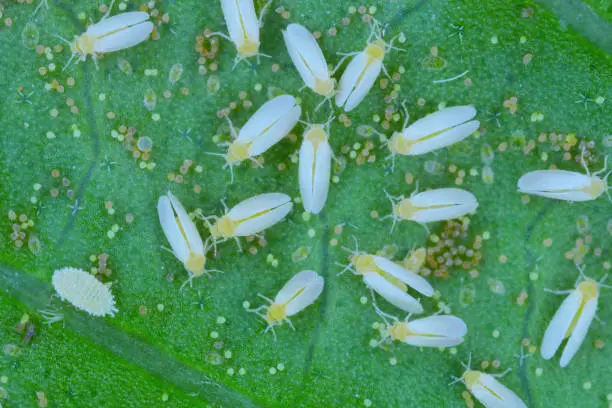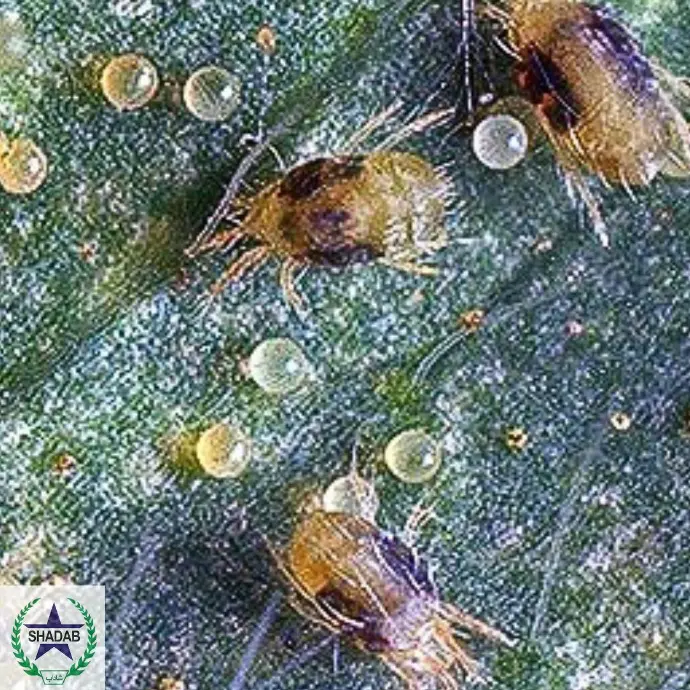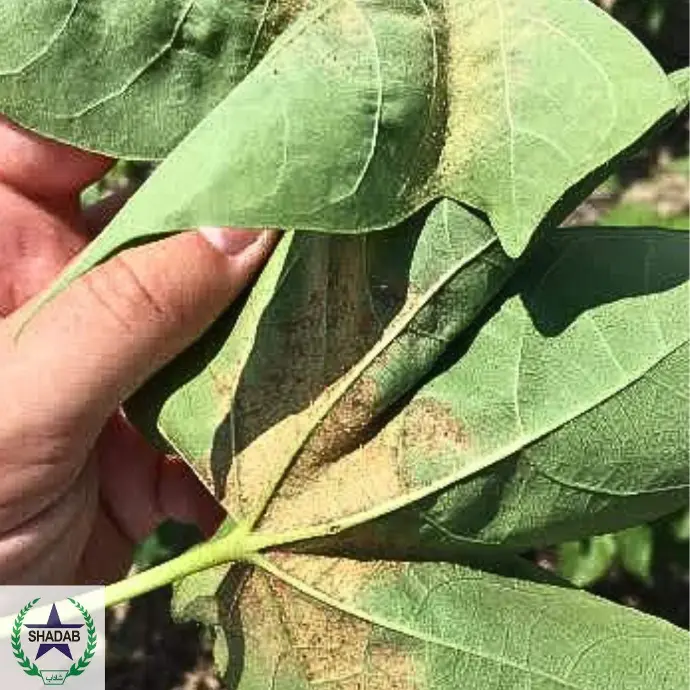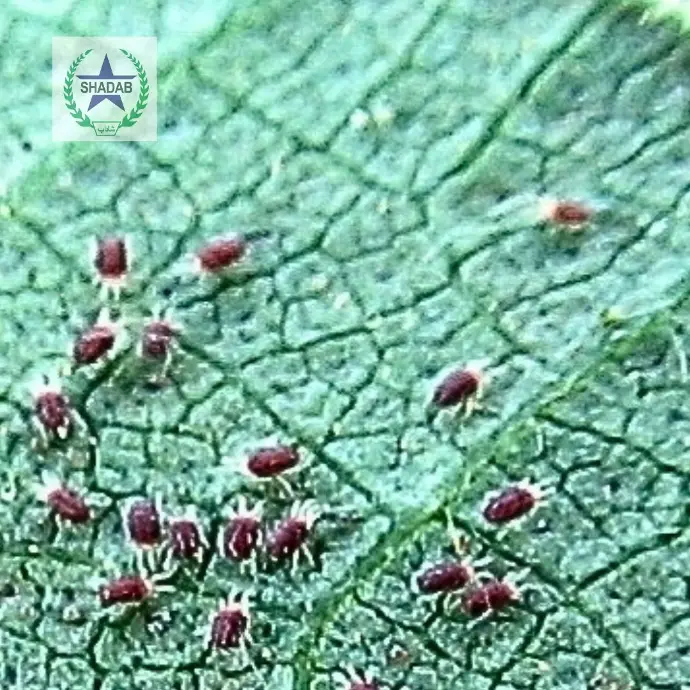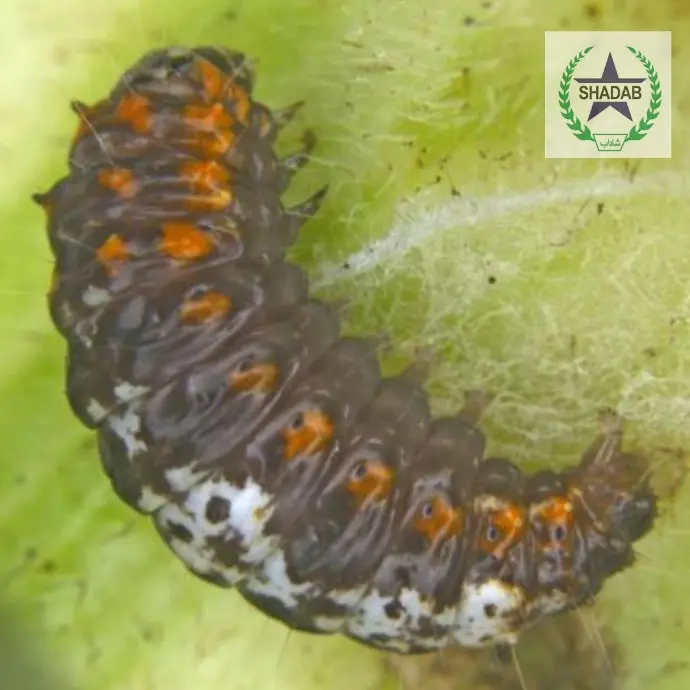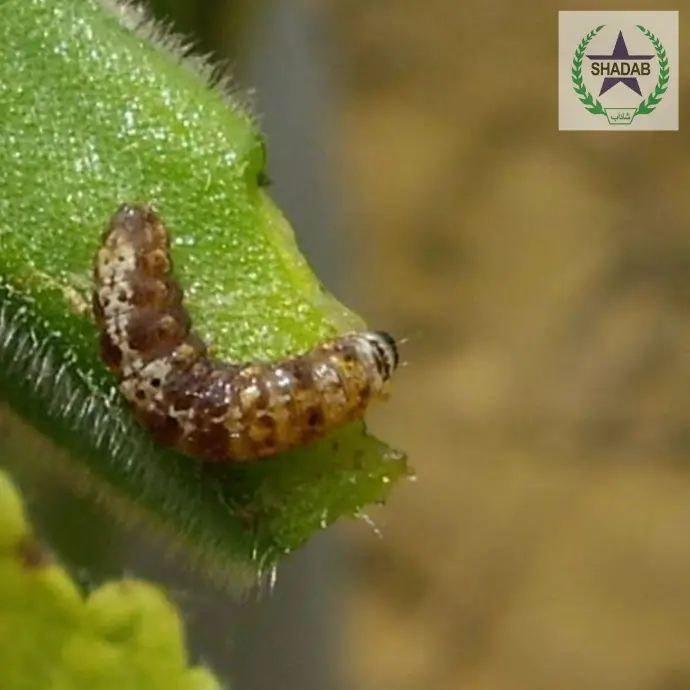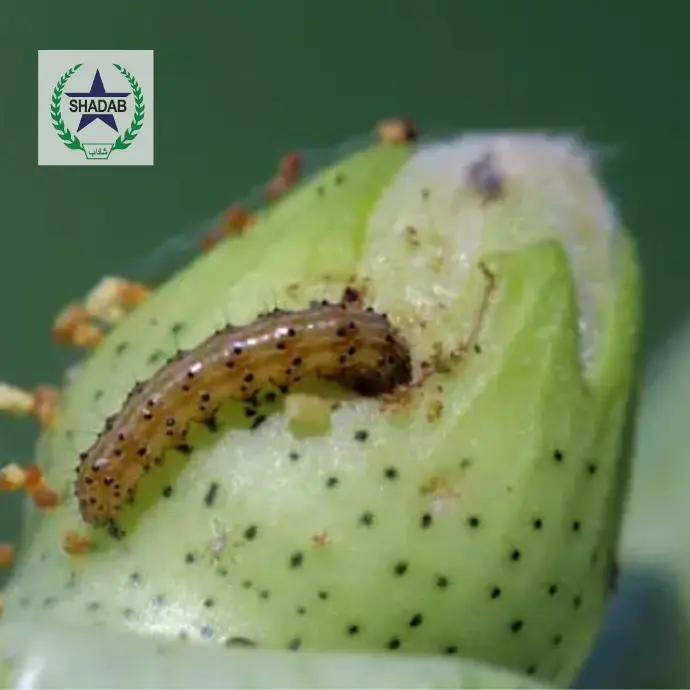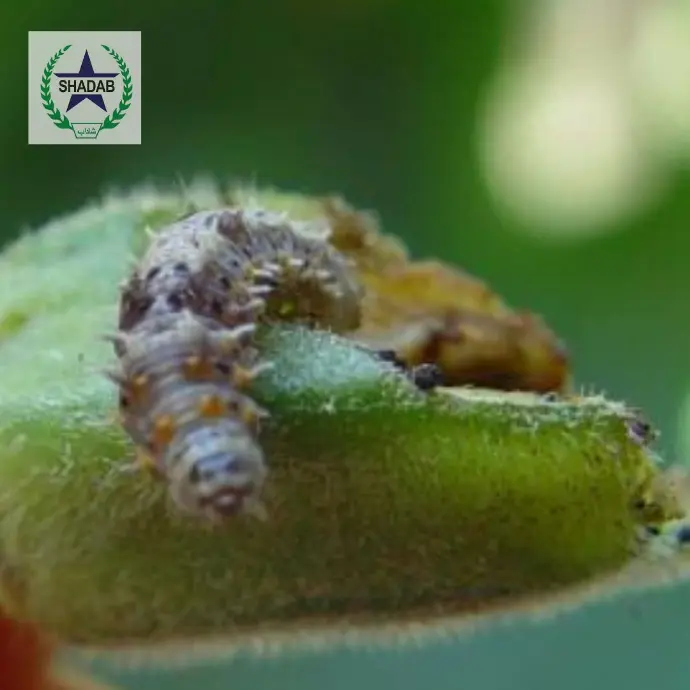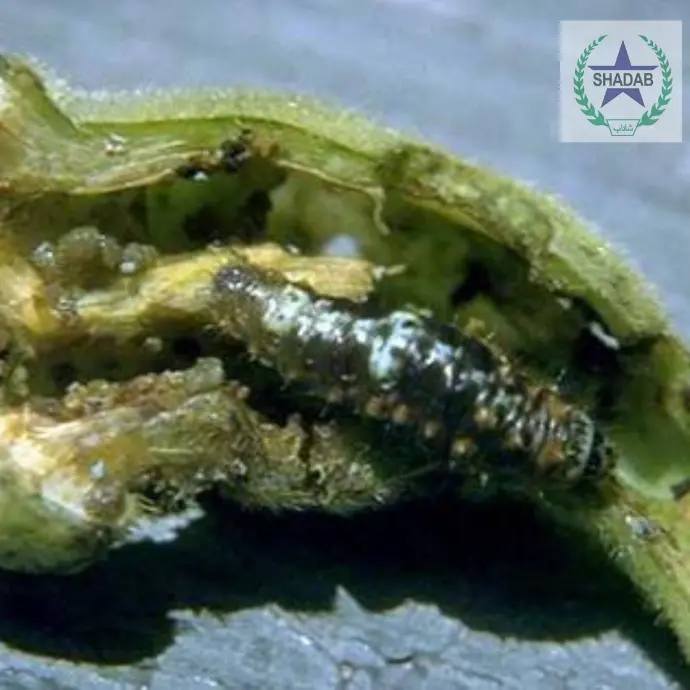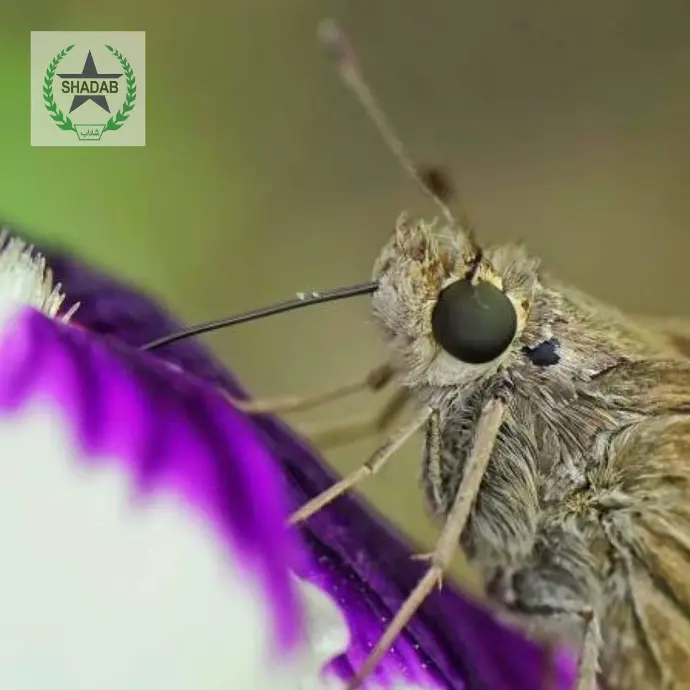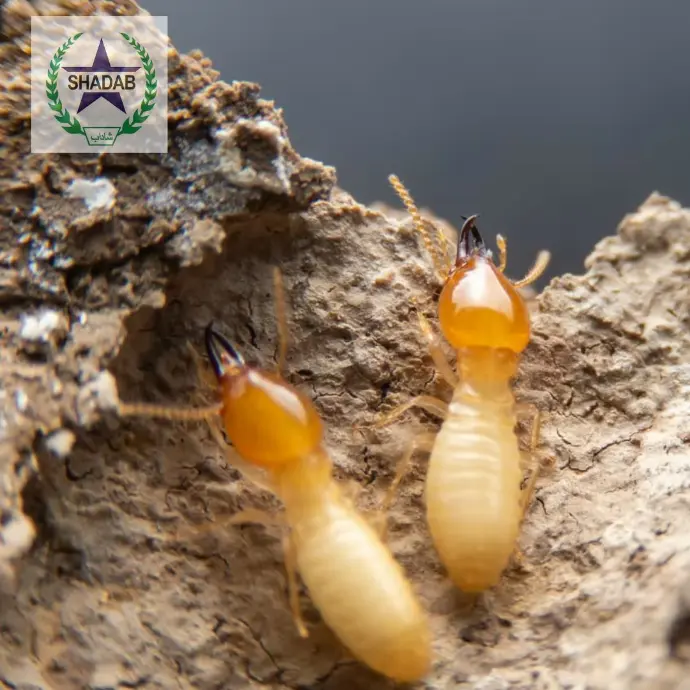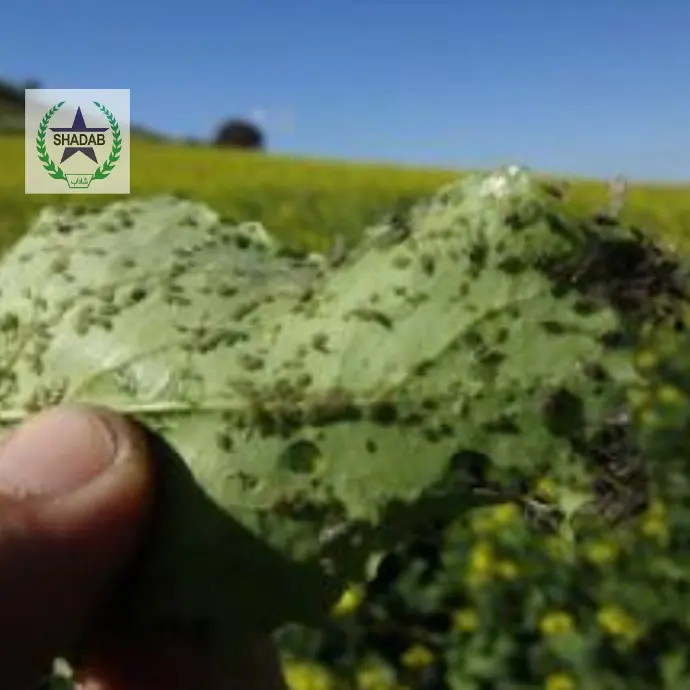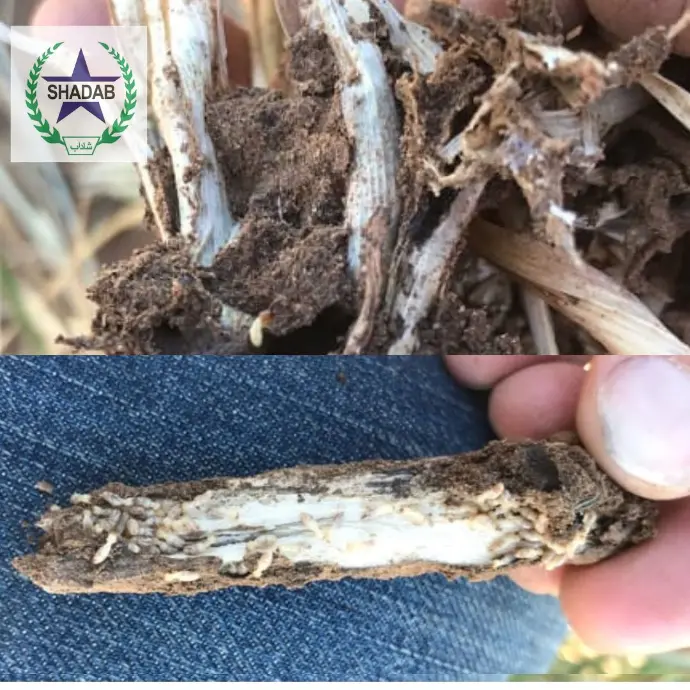INSECT PESTS OF COTTON CROP
In Pakistan Cotton is facing serious damage due to number of pests all of them are listed below their damage, life cycle and Economic threshold level discussed below:
- Cotton Thrips
- Cotton Jassid
- Whitefly
- Mites
- Mealy Bug
- Dusky Cotton Bug
- American Bollworm
- spotted bollworm
- Pink Bollworm
- Army Worm
- Termites
پاکستان میں کپاس کو متعدد کیڑوں کی وجہ سے شدید نقصان کا سامنا ہے ان سب کو ذیل میں درج کیا گیا ہے ان کے نقصانات، زندگی کا چکر اور اقتصادی حد کی سطح ذیل میں زیر بحث ہے:
- کاٹن تھرپس کیڑے
- کاٹن جسد
- سفید مکھی
- مائٹس
- میلی بگ
- ڈسکی کاٹن بگ
- امریکی بیل ورم
- داغ دار کیڑا
- گلابی بیل کیڑا
- آرمی ورم
- دیمک
Cotton Thrips:
Thrips, scientifically known as Thrips tabaci, are small, slender insects typically measuring 1 mm or less in length. They are characterized by their fringed wings and distinctive asymmetrical mouthparts. Various species of thrips primarily feed on plants by puncturing them and extracting their internal fluids. Many of these species are recognized as pests that can significantly impact commercially valuable crops, while a select few act as vectors for more than 20 viruses that lead to plant diseases. In the context of cotton crops, both nymphs and adult thrips cause damage by lacerating leaf tissue and feeding on sap from both the upper and lower leaf surfaces. This feeding behavior involves the injection of saliva, which facilitates the extraction of lysed plant cell contents, ultimately resulting in the appearance of silvery or brown necrotic spots on the leaves. The economic threshold level (ETL) for managing thrips populations is identified as 8-10 per leaf.Thrips،
سائنسی طور پر Thrips tabaci کے نام سے جانا جاتا ہے، چھوٹے، پتلے کیڑے ہوتے ہیں جن کی لمبائی عام طور پر 1 ملی میٹر یا اس سے کم ہوتی ہے۔ ان کی خصوصیت ان کے جھالر والے پروں اور مخصوص غیر متناسب منہ کے حصوں سے ہوتی ہے۔ تھرپس کی مختلف انواع بنیادی طور پر پودوں کو پنکچر کرکے اور ان کے اندرونی سیال نکال کر کھاتی ہیں۔ ان میں سے بہت سی پرجاتیوں کو کیڑوں کے طور پر پہچانا جاتا ہے جو تجارتی لحاظ سے قیمتی فصلوں کو نمایاں طور پر متاثر کر سکتے ہیں، جب کہ کچھ منتخب 20 سے زیادہ وائرسوں کے لیے ویکٹر کے طور پر کام کرتے ہیں جو پودوں کی بیماریوں کا باعث بنتے ہیں۔ کپاس کی فصلوں کے تناظر میں، اپسرا اور بالغ تھرپس دونوں پتوں کے بافتوں کو پھاڑ کر اور پتوں کے اوپری اور نچلے دونوں سطحوں سے رس کو کھانا کھلانے سے نقصان پہنچاتے ہیں۔ کھانا کھلانے کے اس رویے میں تھوک کا انجیکشن شامل ہوتا ہے، جو پودوں کے لیس شدہ خلیوں کے مواد کو نکالنے میں سہولت فراہم کرتا ہے، جس کے نتیجے میں پتوں پر چاندی یا بھورے نیکروٹک دھبے نظر آتے ہیں۔ تھرپس کی آبادی کے انتظام کے لیے اقتصادی حد کی سطح (ETL) کی شناخت 8-10 فی پتی کے طور پر کی گئی ہے۔
Cotton Jassid
The jassid, scientifically known as Amrasca biguttula biguttula, poses a significant threat to cotton cultivation globally, particularly in regions such as Pakistan. Both adult and nymph stages of this pest engage in sap-sucking from the twigs and leaves of cotton plants, which adversely impacts the plants' photosynthetic processes and leads to a decrease in boll formation. The economic threshold level (ETL) for this pest is established at one jassid per leaf. The feeding behavior of both nymphs and adults involves the extraction of plant sap, accompanied by the introduction of salivary toxins that further disrupt photosynthesis in relation to the extent of their feeding. The first and second instar nymphs typically feed near the bases of the leaf veins, while later instars are more widely distributed across the leaves, primarily targeting the undersides.
جسید، سائنسی طور پر امراسکا بگٹولا بگٹولا کے نام سے جانا جاتا ہے، عالمی سطح پر بالخصوص پاکستان جیسے خطوں میں کپاس کی کاشت کے لیے ایک اہم خطرہ ہے۔ اس کیڑے کے بالغ اور اپسرا دونوں مراحل کپاس کے پودوں کی ٹہنیوں اور پتوں سے رس چوسنے میں مشغول ہوتے ہیں، جو پودوں کے فوٹو سنتھیٹک عمل کو بری طرح متاثر کرتے ہیں اور بول کی تشکیل میں کمی کا باعث بنتے ہیں۔ اس کیڑوں کے لیے اقتصادی حد کی سطح (ETL) ایک جسد فی پتی پر قائم کی گئی ہے۔ اپسرا اور بالغ دونوں کے کھانا کھلانے کے رویے میں پودوں کے رس کو نکالنا شامل ہوتا ہے، اس کے ساتھ تھوک کے زہریلے مادوں کا تعارف ہوتا ہے جو ان کے کھانا کھلانے کی حد کے سلسلے میں فوٹو سنتھیس میں مزید خلل ڈالتے ہیں۔ پہلی اور دوسری انسٹار اپسرا عام طور پر پتوں کی رگوں کے اڈوں کے قریب کھانا کھاتے ہیں، جبکہ بعد میں انسٹار زیادہ وسیع پیمانے پر پتوں میں تقسیم ہوتے ہیں، بنیادی طور پر نیچے کی طرف کو نشانہ بناتے ہیں۔
Whitefly
The whitefly, scientifically known as Bemisia tabaci, poses a significant threat to cotton crops by diminishing yields through its feeding habits and the transmission of diseases such as the Cotton Leaf Curl Virus. These pests primarily inhabit the undersides of leaves, where they extract sap, leading to the secretion of a sticky substance that fosters the growth of black fungi. This fungal growth impairs the plant's ability to perform photosynthesis, which is essential for its nourishment and overall vitality.The damage inflicted by whiteflies on cotton plants manifests in two primary forms. Firstly, their sap-sucking behavior directly hampers the plant's photosynthetic efficiency, resulting in reduced yields. Secondly, the honeydew they excrete promotes the development of sooty mold, which not only contaminates the cotton lint but also facilitates the spread of viral diseases. The severity of whitefly infestations, particularly in the later stages of growth, can adversely impact seed development and the quality of the cotton produced.
سفید مکھی، جسے سائنسی طور پر Bemisi tabaci کے نام سے جانا جاتا ہے، کپاس کی فصلوں کے لیے اپنی خوراک کی عادات اور کاٹن لیف کرل وائرس جیسی بیماریوں کی منتقلی کی وجہ سے پیداوار کو کم کرنے کے لیے ایک اہم خطرہ ہے۔ یہ کیڑے بنیادی طور پر پتوں کے نیچے رہتے ہیں، جہاں وہ رس نکالتے ہیں، جس سے ایک چپچپا مادہ خارج ہوتا ہے جو کالی پھپھوندی کی نشوونما کو فروغ دیتا ہے۔ یہ پھپھوندی کی نشوونما پودوں کی روشنی سنتھیسز انجام دینے کی صلاحیت کو متاثر کرتی ہے، جو کہ اس کی پرورش اور مجموعی قوتِ حیات کے لیے ضروری ہے۔ سب سے پہلے، ان کے چوسنے کا رویہ پودوں کی روشنی سنتھیٹک کارکردگی کو براہ راست روکتا ہے، جس کے نتیجے میں پیداوار میں کمی واقع ہوتی ہے۔ دوم، شہد کا جو ان کا اخراج ہوتا ہے وہ سوٹی مولڈ کی نشوونما کو فروغ دیتا ہے، جو نہ صرف روئی کے لِنٹ کو آلودہ کرتا ہے بلکہ وائرل بیماریوں کے پھیلاؤ میں بھی سہولت فراہم کرتا ہے۔ سفید مکھی کے انفیکشن کی شدت، خاص طور پر ترقی کے بعد کے مراحل میں، بیج کی نشوونما اور پیدا ہونے والی کپاس کے معیار کو بری طرح متاثر کر سکتی ہ
Mites
The life cycle of Tetranychus urticae, commonly referred to as spider mites, is characterized by their adaptability to various environments, including brackish and fresh water, hot springs, soil, and a variety of plant species. These mites are also known to act as parasites on animals, including humans. Plant-feeding mites inflict damage primarily by consuming leaf tissues and can also facilitate the spread of viral diseases. Research indicates that there are approximately 45,000 to 48,200 distinct mite species documented in scientific literature.The damage caused by these mites occurs as they penetrate plant cells, particularly on the undersides of leaves, to extract cellular contents. This feeding behavior can result in the destruction of 12 to 24 cells per minute. Initial signs of infestation include small white speckles, predominantly near the midrib and larger veins of the leaves. As these speckles coalesce, they create a whitish or silvery-transparent appearance on the leaf surface. In cases of severe infestation, leaves may exhibit yellowing, wilting, and eventual shedding, leading to complete defoliation. The reduction in photosynthetically active leaf area, coupled with diminished transpiration, can significantly impact crop yield, potentially stunting plant growth or resulting in plant death.
مکڑی کے ذرات کی زندگی کا چکر، جسے عام طور پر مکڑی کے ذرات کہا جاتا ہے، مختلف ماحول میں ان کی موافقت کی خصوصیت ہے، بشمول نمکین اور تازہ پانی، گرم چشمے، مٹی، اور پودوں کی مختلف اقسام۔ یہ ذرات انسانوں سمیت جانوروں پر پرجیویوں کے طور پر کام کرنے کے لیے بھی جانا جاتا ہے۔ پودوں کو کھانا کھلانے والے ذرات بنیادی طور پر پتوں کے بافتوں کو کھا کر نقصان پہنچاتے ہیں اور یہ وائرل بیماریوں کے پھیلاؤ میں بھی سہولت فراہم کر سکتے ہیں۔ تحقیق سے پتہ چلتا ہے کہ سائنسی لٹریچر میں تقریباً 45,000 سے 48,200 الگ الگ انواع موجود ہیں۔ ان مائیٹس کی وجہ سے ہونے والا نقصان اس وقت ہوتا ہے جب وہ پودوں کے خلیوں میں گھس جاتے ہیں، خاص طور پر پتوں کے نیچے سے، سیلولر مواد کو نکالنے کے لیے۔ کھانا کھلانے کے اس رویے کے نتیجے میں 12 سے 24 خلیات فی منٹ تباہ ہو سکتے ہیں۔ انفیکشن کی ابتدائی علامات میں چھوٹے سفید دھبے شامل ہیں، بنیادی طور پر درمیانی اور پتوں کی بڑی رگوں کے قریب۔ جیسے جیسے یہ دھبے اکٹھے ہو جاتے ہیں، وہ پتے کی سطح پر سفید یا چاندی کی شفاف شکل پیدا کرتے ہیں۔ شدید انفیکشن کی صورتوں میں، پتے زرد، مرجھانے، اور آخرکار گرنے کی نمائش کر سکتے ہیں، جس سے مکمل کٹائی ہو جاتی ہے۔ پتوں کے رقبے میں فوٹوسنتھیٹک طور پر فعال کمی، کم ہونے والے ٹرانسپائریشن کے ساتھ، فصل کی پیداوار کو نمایاں طور پر متاثر کر سکتی ہے، ممکنہ طور پر پودوں کی نشوونما کو روک سکتی ہے یا اس کے نتیجے میں پودے کی موت واقع ہو سکتی ہے۔
Cotton Mealy Bug
The cotton mealybug, scientifically known as Phenacoccus solenopsis, is a significant pest that targets cotton crops. This insect feeds on the cell sap of various plant parts, including leaves, fruits, and twigs. When infestations are severe, they can lead to stunted growth and delayed maturation of cotton bolls, ultimately resulting in a substantial decrease in yield.
Cotton Mealy Bug
The mealybug primarily consumes soft plant tissues and introduces saliva into the plant, which can cause leaf curling and other detrimental effects.The damage inflicted by the cotton mealybug is considerable, as it extracts large quantities of sap from the leaves and stems using its specialized piercing and sucking mouthparts. This feeding behavior deprives the plants of vital nutrients, leading to symptoms such as wilting, yellowing of leaves, and inhibited growth. Additionally, the pest disrupts the photosynthesis process, delays the opening of bolls, and can even result in defoliation or the death of the affected plants.
Contact usمیلی بگ بنیادی طور پر پودوں کے نرم بافتوں کو کھاتا ہے اور لعاب کو پودے میں داخل کرتا ہے، جو پتوں کے جھرنے اور دیگر نقصان دہ اثرات کا سبب بن سکتا ہے۔ روئی کے میلی بگ سے ہونے والا نقصان کافی ہوتا ہے، کیونکہ یہ اپنے مخصوص سوراخوں کا استعمال کرتے ہوئے پتوں اور تنوں سے بڑی مقدار میں رس نکالتا ہے۔ اور منہ کے حصوں کو چوسنا. کھانا کھلانے کا یہ رویہ پودوں کو اہم غذائی اجزا سے محروم کر دیتا ہے، جس کی وجہ سے مرجھا جانا، پتوں کا پیلا ہونا، اور نشوونما میں رکاوٹ پیدا ہو جاتی ہے۔ مزید برآں، کیڑے فوٹو سنتھیس کے عمل میں خلل ڈالتے ہیں، بالوں کے کھلنے میں تاخیر کرتے ہیں، اور یہاں تک کہ اس کے نتیجے میں متاثرہ پودوں کے پتے گر سکتے ہیں ۔
Dusky Cotton Bug
The dusky cotton bug, scientifically known as Oxycarenus hyalinipennis, has transitioned from being regarded as a minor pest to a significant threat to cotton crops due to its rising population in recent years. This pest is capable of producing multiple generations throughout the year and has also been observed feeding on other plants, including okra.
DAMAGE?
The economic threshold level (ETL) for management is set at 15 individuals per plant, whether they are adults or nymphs.The presence of dusky cotton bugs can lead to various detrimental effects, including a reduction in both the weight and oil content of cotton seeds, ultimately resulting in decreased cotton yields. Furthermore, during the ginning process, these bugs are often crushed, which can stain the cotton lint and diminish its market value, leading to financial losses for producers.
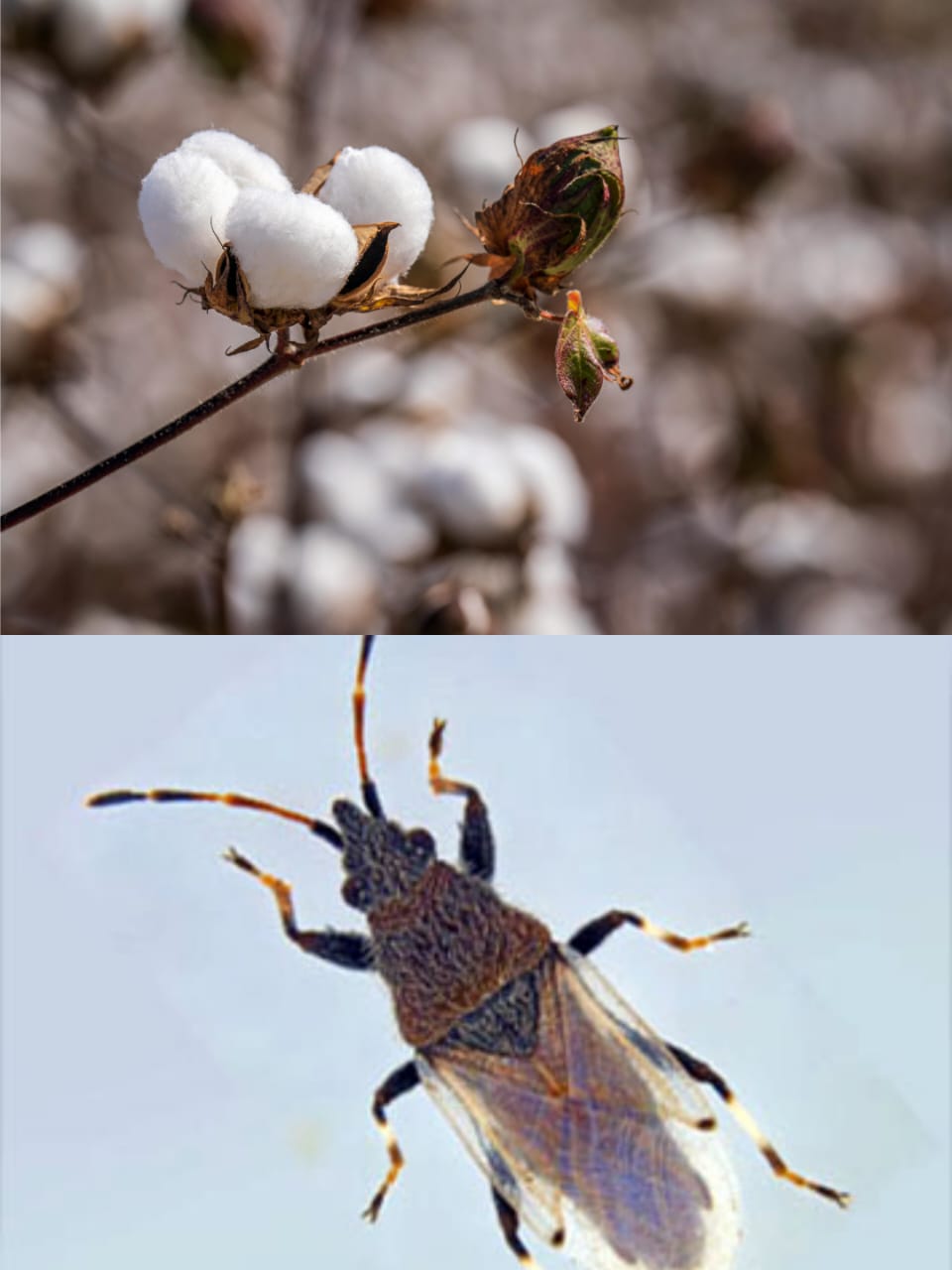
دھول دار کاٹن بگ، حالیہ برسوں میں اس کی بڑھتی ہوئی آبادی کی وجہ سے کپاس کی فصلوں کے لیے ایک معمولی کیڑوں کے طور پر شمار ہونے سے ایک اہم خطرہ میں تبدیل ہو گیا ہے۔ یہ کیڑا سال بھر میں متعدد نسلیں پیدا کرنے کی صلاحیت رکھتا ہے اور اسے بھنڈی سمیت دیگر پودوں پر بھی کھانا کھلاتے دیکھا گیا ہے۔ انتظام کے لیے اقتصادی حد کی سطح (ای ٹی ایل) 15 افراد فی پودے پر مقرر کی گئی ہے، چاہے وہ بالغ ہوں یا اپسرے۔ ، بالآخر کپاس کی پیداوار میں کمی کے نتیجے میں۔ مزید برآں، جننگ کے عمل کے دوران، یہ کیڑے اکثر کچلے جاتے ہیں، جو کپاس کے لِنٹ پر داغ ڈال سکتے ہیں اور اس کی مارکیٹ ویلیو کو کم کر سکتے ہیں، جس سے پروڈیوسروں کو مالی نقصان ہوتا ہے۔
American Bollworm
The American Bollworm, scientifically known as Helicoverpa armigera, is a significant pest affecting cotton crops. The economic threshold level (ETL) for this pest is established at 5, which can be represented by either 5 brown eggs, 3 small larvae, or a total of 5 individuals per 25 plants. The larvae of this pest initially consume the leaves of the cotton plant before burrowing into the squares and seeds, with their heads inserted into the bolls while the remainder of their bodies remains exposed. They exhibit a preference for feeding on squares and flowers when available, but they also target young bolls. A single larva has the potential to inflict damage on 30 to 40 fruiting forms throughout its growth cycle. Additionally, these larvae facilitate the spread of boll rot pathogens, leading to the decay of damaged bolls and subsequent reductions in crop yield.
امریکی بول ورم، جسے سائنسی طور پر ہیلی کوورپا آرمیگرا کہا جاتا ہے، کپاس کی فصلوں کو متاثر کرنے والا ایک اہم کیڑا ہے۔ اس کیڑوں کے لیے اقتصادی حد کی سطح (ETL) 5 پر قائم کی گئی ہے، جس کی نمائندگی یا تو 5 بھورے انڈے، 3 چھوٹے لاروا، یا کل 5 افراد فی 25 پودوں سے کی جا سکتی ہے۔ اس کیڑے کے لاروا شروع میں کپاس کے پودے کے پتوں کو چوکوں اور بیجوں میں دفن کرنے سے پہلے کھا لیتے ہیں، ان کے سروں کو گیندوں میں ڈال دیا جاتا ہے جبکہ ان کے جسم کا باقی حصہ کھلا رہتا ہے۔ وہ دستیاب ہونے پر چوکوں اور پھولوں کو کھانا کھلانے کو ترجیح دیتے ہیں، لیکن وہ نوجوان بیلوں کو بھی نشانہ بناتے ہیں۔ ایک لاروا اپنی نشوونما کے دوران 30 سے 40 پھلوں کی شکلوں کو نقصان پہنچانے کی صلاحیت رکھتا ہے۔ مزید برآں، یہ لاروا بول روٹ پیتھوجینز کے پھیلاؤ میں سہولت فراہم کرتے ہیں، جس کے نتیجے میں نقصان شدہ بولوں کے زوال اور فصل کی پیداوار میں کمی واقع ہوتی ہے۔
Spotted bollworm
The Spotted Bollworm, scientifically known as Earias vitella or E. insulana, is a significant pest affecting cotton crops. Commonly referred to as چتکبری سنڈی, this insect's life cycle poses a considerable threat to cotton production. The economic threshold level (ETL) for this pest is established at three larvae per twenty-five plants, indicating the need for vigilant monitoring and management.The larvae of the Spotted Bollworm primarily target the growing shoots, resulting in drooping and wilting of the top shoot. As the infestation progresses, the damage extends to buds, flowers, and bolls, leading to premature opening of flower buds, a phenomenon known as "flared squares." Additionally, the larvae consume the pulp within the bolls, which not only reduces yield but also causes staining of the lint, further compromising the quality of the cotton.
کپاس کی فصل کو متاثر کرنے والا ایک اہم کیڑا ہے۔ عام طور پر بالغ کے طور پر کہا جاتا ہے، اس کیڑے کی زندگی کا چکر کپاس کی پیداوار کے لیے کافی خطرہ ہے۔ اس کیڑے کے لیے اقتصادی حد کی سطح (ETL) فی پچیس پودوں پر تین لاروا پر قائم ہے، جو چوکس نگرانی اور انتظام کی ضرورت کی نشاندہی کرتی ہے۔ دھبے والے بول ورم کے لاروا بنیادی طور پر بڑھتی ہوئی ٹہنیوں کو نشانہ بناتے ہیں، جس کے نتیجے میں اوپر کا حصہ جھک جاتا ہے اور مرجھا جاتا ہے۔ گولی مار جیسے جیسے انفیکشن بڑھتا ہے، نقصان کلیوں، پھولوں اور گیندوں تک پھیلتا ہے، جس کے نتیجے میں پھولوں کی کلیاں وقت سے پہلے کھل جاتی ہیں، ایک ایسا رجحان جسے "بھڑکتے ہوئے چوکور" کہا جاتا ہے۔ مزید برآں، لاروا گودے کو گودے کے اندر کھا لیتے ہیں، جس سے نہ صرف پیداوار کم ہوتی ہے بلکہ لنٹ پر داغ پڑنے کا بھی سبب بنتا ہے، جس سے روئی کے معیار پر مزید سمجھوتہ ہوتا ہے۔
Pink Bollworm
The pink bollworm, scientifically known as Pectinophora gossypiella, is a significant pest affecting cotton crops. The economic threshold level (ETL) for this pest is established at five larvae per 100 bolls. The larvae primarily target flower buds that are less than ten days old, resulting in bud shedding and subsequent larval mortality. However, in older buds, the larvae can successfully complete their development. It is possible for bolls to experience a complete infestation by pink bollworms without any visible shedding of the buds.The larvae create webbing within the flower buds, which hinders the proper opening of the flowers and results in a condition known as "rosetted-bloom." Bolls that are ten to twenty days old are particularly vulnerable, as the larvae attack from beneath the bracteoles and feed on the developing seeds. In younger bolls, the larvae can destroy the entire contents, while in older bolls, they may complete their development by feeding on three to four seeds. Additionally, multiple larvae can infest a single boll, exacerbating the damage to the crop.
گلابی بول کیڑا، کپاس کی فصلوں کو متاثر کرنے والا ایک اہم کیڑا ہے۔ اس کیڑے کے لیے اقتصادی حد کی سطح (ETL) پانچ لاروا فی 100 بولس پر قائم کی گئی ہے۔ لاروا بنیادی طور پر ان پھولوں کی کلیوں کو نشانہ بناتے ہیں جو دس دن سے کم پرانی ہوتی ہیں، جس کے نتیجے میں کلیوں کا اخراج اور لاروا کی موت واقع ہوتی ہے۔ تاہم، پرانی کلیوں میں، لاروا کامیابی سے اپنی نشوونما مکمل کر سکتے ہیں۔ پھولوں کے لیے یہ ممکن ہے کہ وہ گلابی کیڑے کے ذریعے کلیوں کے بغیر کسی نظر آنے کے مکمل انفیکشن کا تجربہ کریں۔ لاروا پھولوں کی کلیوں کے اندر جال بنتا ہے، جو پھولوں کے صحیح کھلنے میں رکاوٹ بنتا ہے اور اس کے نتیجے میں ایسی حالت پیدا ہوتی ہے جسے "روزٹڈ بلوم" کہا جاتا ہے۔ " دس سے بیس دن پرانے بولز خاص طور پر کمزور ہوتے ہیں، کیونکہ لاروا بریکٹیل کے نیچے سے حملہ کرتے ہیں اور نشوونما پانے والے بیجوں کو کھاتے ہیں۔ چھوٹے بالوں میں، لاروا پورے مواد کو تباہ کر سکتا ہے، جب کہ بڑی بوڑھوں میں، وہ تین سے چار بیجوں کو کھلا کر اپنی نشوونما مکمل کر سکتے ہیں۔ مزید برآں، متعدد لاروا ایک ہی بال کو متاثر کر سکتے ہیں، جو فصل کو پہنچنے والے نقصان کو بڑھاتے ہیں۔
Army Worm
The life cycle of the armyworm, scientifically known as Spodoptera litura or S. exigua, poses significant challenges to cotton crops. Initially, the early instars are located in the lower to mid-levels of the plant canopy, where they primarily consume the foliage. During the early stages of the cotton-growing season, these larvae exhibit a behavior known as "skeletonizing," where they feed on the leaves adjacent to the egg mass from which they emerged. As the season progresses, later instars can severely damage the terminals of cotton seedlings, while older larvae tend to inhabit the lower regions of the plant, targeting fruiting structures.As the larvae mature, they inflict damage on bracts, large squares, and young bolls, exhibiting feeding patterns similar to those of the bollworm. In cases of heavy infestations, all fruiting forms of the cotton plant may be at risk. The larger larvae often feed internally within the fruiting structures, complicating effective chemical control measures. This behavior underscores the importance of monitoring and managing armyworm populations to mitigate their impact on cotton production.
آرمی ورم کا لائف سائیکل، جو سائنسی طور پر اسپوڈوپٹیرا لٹورا یا ایس ایگزیگوا کے نام سے جانا جاتا ہے، کپاس کی فصلوں کے لیے اہم چیلنجز پیش کرتا ہے۔ ابتدائی طور پر، ابتدائی ستارے پودے کی چھتری کے نچلے سے درمیانی درجے میں واقع ہوتے ہیں، جہاں وہ بنیادی طور پر پودوں کو کھاتے ہیں۔ کپاس اگانے کے سیزن کے ابتدائی مراحل کے دوران، یہ لاروا ایک ایسے رویے کی نمائش کرتے ہیں جسے "کنکال سازی" کہا جاتا ہے، جہاں وہ انڈے کے بڑے پیمانے سے ملحقہ پتوں کو کھاتے ہیں جہاں سے وہ نکلے تھے۔ جیسے جیسے موسم آگے بڑھتا ہے، بعد میں آنے والے انسٹارز کپاس کے بیجوں کے ٹرمینلز کو شدید نقصان پہنچا سکتے ہیں، جب کہ پرانے لاروا پودے کے نچلے علاقوں میں رہتے ہیں، پھل دار ڈھانچے کو نشانہ بناتے ہیں۔ کیڑے کے کیڑے سے ملتے جلتے کھانا کھلانے کے نمونوں کی نمائش۔ بھاری انفیکشن کی صورت میں، کپاس کے پودے کی تمام پھلدار شکلیں خطرے میں ہو سکتی ہیں۔ بڑے لاروا اکثر پھل دار ڈھانچے کے اندر داخل ہوتے ہیں، مؤثر کیمیائی کنٹرول کے اقدامات کو پیچیدہ بناتے ہیں۔ یہ رویہ کپاس کی پیداوار پر ان کے اثرات کو کم کرنے کے لیے آرمی کیڑے کی آبادی کی نگرانی اور انتظام کی اہمیت کو واضح کرتا ہے۔
Termites
Termites, scientifically classified under the genus Odontotermes spp, are a highly successful group of insects that inhabit nearly all terrestrial environments, with the exception of Antarctica. Their colonies can vary significantly in size, ranging from a few hundred members to vast communities comprising millions of individuals. Notably, termite queens possess the longest lifespan among insects, with some individuals living between 30 to 50 years. Often referred to as "silent destroyers," these insects have a remarkable ability to consume wood, flooring, and even wallpaper without being detected.The damage caused by termites is particularly detrimental to agricultural crops, such as canola, as they create tunnels beneath the soil, affecting the plant's root system and leading to its eventual death. This underground mining behavior not only compromises the structural integrity of the plants but also poses a significant threat to crop yields, necessitating effective management strategies to mitigate their impact on agriculture.
دیمک کیڑوں کا ایک انتہائی کامیاب گروہ ہے جو انٹارکٹیکا کے علاوہ تقریباً تمام زمینی ماحول میں رہتا ہے۔ ان کی کالونیاں سائز میں نمایاں طور پر مختلف ہو سکتی ہیں، جن میں چند سو ممبران سے لے کر لاکھوں افراد پر مشتمل وسیع کمیونٹیز شامل ہیں۔ خاص طور پر، دیمک کی ملکہ کیڑوں میں سب سے طویل عمر ہوتی ہے، کچھ افراد 30 سے 50 سال کے درمیان رہتے ہیں۔ جن کو اکثر "خاموش تباہ کن" کہا جاتا ہے، ان کیڑوں میں لکڑی، فرش اور یہاں تک کہ وال پیپر کو بغیر پتہ چلائے استعمال کرنے کی قابل ذکر صلاحیت ہوتی ہے۔ دیمک کی وجہ سے ہونے والا نقصان خاص طور پر زرعی فصلوں، جیسے کینولا کے لیے نقصان دہ ہے، کیونکہ وہ نیچے سرنگیں بناتے ہیں۔ مٹی، پودے کے جڑ کے نظام کو متاثر کرتی ہے اور اس کی موت کا باعث بنتی ہے۔ زیر زمین کان کنی کا یہ رویہ نہ صرف پودوں کی ساختی سالمیت سے سمجھوتہ کرتا ہے بلکہ فصل کی پیداوار کے لیے بھی ایک اہم خطرہ ہے، جس سے زراعت پر ان کے اثرات کو کم کرنے کے لیے موثر انتظامی حکمت عملیوں کی ضرورت ہے۔
